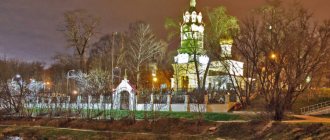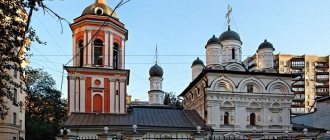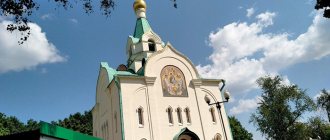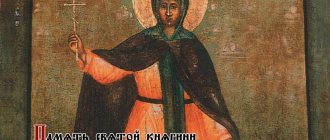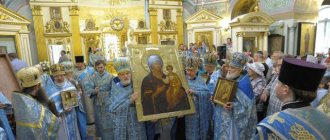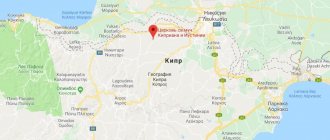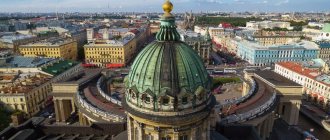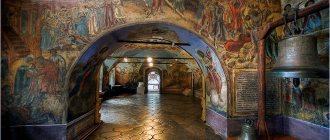Mir
Russia St. Petersburg Church of the Blessed Anna Kashinskaya (St. Petersburg) Map is loading...
{"format":"leaflet","minzoom":false,"maxzoom":false,"limit":50,"offset":0,"link":"all","sort":[""], "order":[],"headers":"show","mainlabel":"","intro":"","outro":"","searchlabel":"\u2026 \u0441\u043b\u0435\ u0434\u0443\u044e\u0449\u0438\u0435 \u0440\u0435\u0437\u0443\u043b\u044c\u0442\u0430\u0442\u044b","default":"","import-annotation":false,"width ":"auto","height":"350px","centre":{"text":"","title":"""link":"""lat":59.97028000000000247382558882236480712890625,"lon": 30.341390000000000526370058651082217693328857421875,"icon":""},"title":"","label":"","icon":"","lines":[],"polygons":[],"circles":[ ],"rectangles":[],"copycoords":false,"static":false,"zoom":8,"defzoom":14,"layers":["OpenStreetMap"],"image layers":[] ,"overlays":[],"resizable":false,"fullscreen":true,"scrollwheelzoom":true,"cluster":false,"clustermaxzoom":9,"clusterzoomonclick":true,"clustermaxradius":80, "clusterspiderfy":true,"geojson":"","clicktarget":"","showtitle":true,"hidenamespace":false,"template":"","userparam":"","activeicon": "","pagelabel":false,"ajaxcoordproperty":"","ajaxquery":"","locations":[{"text":"\u003Cb\u003E\u003Ca href=\"/palomnik/%D0% A6%D0%B5%D1%80%D0%BA%D0%BE%D0%B2%D1%8C_%D0%B1%D0%BB%D0%B0%D0%B3%D0%BE%D0%B2% D0%B5%D1%80%D0%BD%D0%BE%D0%B9_%D0%90%D0%BD%D0%BD%D1%8B_%D0%9A%D0%B0%D1%88%D0% B8%D0%BD%D1%81%D0%BA%D0%BE%D0%B9_(%D0%A1%D0%B0%D0%BD%D0%BA%D1%82-%D0%9F%D0% B5%D1%82%D0%B5%D1%80%D0%B1%D1%83%D1%80%D0%B3)\» title=\»\u0426\u0435\u0440\u043a\u043e\u0432\u044c \u0431\u043b\u0430\u0433\u043e\u0432\u0435\u0440\u043d\u043e\u0439 \u0410\u043d\u043d\u044b \u041a\u0430\u0448\u0438\u043d\ u0441\u043a\u043e\u0439 (\ u0421\u0430\u043d\u043a\u0442-\u041f\u0435\u0442\u0435\u0440\u0431\u0443\u0440\u0433)\»\u003E\u0426\u0435\u0440\u043a\u043e\ u0432\u044c\u0431\ u043b\u0430\u0433\u043e\u0432\u0435\u0440\u043d\u043e\u0439 \u0410\u043d\u043d\u044b \u041a\u0430\u0448\u0438\u043d\u0441\u0 43a\u043e\u0439 (\u0421\u0430 h ref=\"/ palomnik/%D0%A1%D0%B2%D0%BE%D0%B9%D1%81%D1%82%D0%B2%D0%BE:%D0%90%D0%BD%D0%BD%D0% BE%D1%82%D0%B0%D1%86%D0%B8%D1%8F\" title=\"\u0421\u0432\u043e\u0439\u0441\u0442\u0432\u043e:\u0410\u043d\u043d \u043e\u0442\u0430\u0446\u0438\u044f\»\u003E\u0410\u043d\u043d\u043e\u0442\u0430\u0446\u0438\u044f\u003C/a\u003E: \u043f\u0 43e\u0441\u0442\ u0440\u043e\u0435\u043d\u0430 \u0432 1907-1909 \u0433\u043e\u0434\u0430\u0445, \u0441\u0435\u0439\u0447\u0430\u0441 \u044f\u 0432\u043b\u044f\u0435\u0442\ u0441\u044f \u043f\u043e\u0434\u0432\u043e\u0440\u044c\u0435\u043c [[\u0412\u0432\u0435\u0434\u0435\u043d\u043e-\u041e\u044f\ u0442\u0441\u043a\u0438 \u0439 \u0436\u0435\u043d\u0441\u043a\u0438\u0439 \u043c\u043e\u043d\u0430\u0441\u0442\u044b\u0440\u044c|\u0412\u0432\u0435 \u0434\u0435\u043d\u043e- \u041e\u044f\u0442\u0441\u043a\u043e\u0433\u043e \u043c\u043e\u043d\u0430\u0441\u0442\u044b\u0440\u044f]]","title":"\u0426\u0435 \u0440 \u043a\u043e\u0432\u044c \u0431\u043b\u0430\u0433\u043e\u0432\u0435\u0440\u043d\u043e\u0439 \u0410\u043d\u043d\u044b \u041a \u0430\u0448\u0438\u043d\u0441 \u043a\u043e\u0439 (\u0421\u0430\u043d\u043a\u0442-\u041f\u0435\u0442\u0435\u0440\u0431\u0443\u0440\u0433)","link":"","lat": 59.97028000000000247382558882236480712890625,"lon":30.341390000000000526370058651082217693328857421875,"icon":""}],,"imageLayers":[]}
59.970335; 30.341551
Russia, St. Petersburg, Bolshoi Sampsonievsky Prospekt, 47
Saint Petersburg
Russia
Telephone.:
8 (812) 542-54-74
Email:
Church of St. Anna Kashinskaya
Built in 1907-1909, it is now the courtyard of the Vvedeno-Oyatsky Monastery. Patronal holidays: October 15, June 25, August 3, days of memory of the blessed Anna Kashinskaya.
History[edit]
Construction of the courtyard of the Kashinsky Sretensky Monastery began in 1907 on the site where the chapel of St. Nicholas the Wonderworker stood, built in 1894 in memory of the miraculous salvation of the future Emperor Nicholas II in Japan. The drafting of the courtyard project was entrusted to the diocesan architect A.P. Aplaksin. The project included a two-story church with a chapel attached to it and residential buildings of the courtyard.
In November 1907, the new chapel of St. Nicholas the Wonderworker was consecrated. In February 1908, the side chapel of the Savior Not Made by Hands was consecrated in the lower church. The main chapel was consecrated in the name of Anna Kashinskaya in 1909.
In 1917, the courtyard was abolished, and the church became a parish. At the beginning of the 1930s, the church was also closed, some icons were transferred to Sampsonievsky Cathedral. In 1934, the church was prepared for an explosion, which, however, did not take place. In 1939, the church housed art workshops.
After two years of neglect, in 1994 the entire complex of the metochion was given to the Vvedeno-Oyatsky convent. The church was in disrepair - with dilapidated brickwork, demolished domes, broken glass, a flooded basement, and failed engineering systems.
In 1995, restoration work began.
Revered Shrines
Before the destruction of the monastery, there were miraculous images of the Chernigov Mother of God and the blessed princess Anna Kashinskaya. After the arrest of the nuns, they were transferred to the nearby St. Sampsonievsky Cathedral.
Today the church houses the following shrines:
- the image of the Blessed Virgin Mary “Oranta - Great Panagia”, executed in stained glass technique by the artist Tarakanovsky;
- the image of the blessed Anna Kashinskaya with a reliquary, which contains particles of the relics of the princess;
- myrrh-streaming image of the Archangel Michael.
Patronal holiday
In the parish, church celebrations are held on the following days:
- October 15 – commemoration of the repose of the blessed princess Anna in 1368.
- June 25 – transfer of the relics of the saint from the Assumption Cathedral to the Resurrection Cathedral (1650) and her re-canonization (1909).
- August 3 – remembrance of the discovery of relics (1649).
Architecture and interior decoration[edit]
The temple, which has four pillars in design, is divided by pylons into three naves, the side of which are two-story galleries. In 1911, on the upper floors of these galleries, chapels were consecrated in the name of Nicholas the Wonderworker and St. Alexis, Metropolitan of Moscow, the wonderworker.
The architecture of the temple displays the features of Pskov-Novgorod architecture of the 15th century. The walls are plastered in a dark red color. The church is crowned with a helmet-shaped, pointed dome on a low drum. The dominant architectural composition is a slender three-tier bell tower topped with an onion dome. In plan, the main part of the bell tower has a square shape, the third tier is round. Majolica icons and paintings were included in the decorative design of the facades. The porch was made in the Russian style, topped with an onion-shaped dome with an imperial crown.
Schedule of services[edit]
Divine services in the Church of St. Anna Kashinskaya are performed daily.
During weekdays:
- Monday: Liturgy at 9:00
- Tuesday: Liturgy at 9:00
- Wednesday: Liturgy at 9:00
- Thursday: Liturgy at 9:00; prayer service with akathist to St. Nicholas the Wonderworker at 18:00.
- Friday: Liturgy at 7:30, prayer service with akathist to the Tikhvin Icon of the Mother of God at 18:00.
- Saturday: Liturgy at 10:00; All-night Vigil at 18:00.
- Sunday: Liturgy at 10:00; Vespers with Akathist to St. Anna Kashinskaya at 18:00.
On the twelve and great holidays:
- on the eve of the holiday - All-Night Vigil at 18:00;
- on the day of the holiday - Liturgy at 10:00.
Relics of the Holy Blessed Princess Anna Kashinskaya
Far from the Moscow noise and endless bustle of the big city, there is a small, but at the same time incredibly cozy and friendly town called Kashin. The Kashinka River, after which the city is named, makes several bends, forming the shape of a heart when viewed from above, which is why Kashin is often called the “city of the Russian heart.”
View of the Kashinka River
(Photo from magput.ru)
However, this small town is known not only because of the river with such a very unusual shape and well-known mineral water: in the Ascension Cathedral of Kashin, for more than twenty years (since 1993), the relics of the holy blessed princess Anna Kashin have been kept.
Princess Anna Kashinskaya was born at the end of the 13th century (in October 1280) and received her name in honor of the holy righteous Anna, the mother of the Blessed Virgin Mary. The young princess Anna was married to the Tver prince Mikhail at a very early age - at the age of 14, the wedding of the couple took place in the Tver Spassky Cathedral.
The Lord gave the couple five children: a daughter, Theodora, in 1299 (the girl died in infancy) and four sons: Dmitry (known as Terrible Eyes) in 1300, Alexander in 1301, Constantine in 1306, and Vasily in 1309. The princess herself was involved in raising her children, paying a lot of attention to their education. Her children learned true Christian life thanks to her own example: they prayed with their mother and attended services with her.
Many sorrows and trials befell Saint Anna both during her life and after it. In the same year, when the princess got married, her father died, and Anna and her sister Vasilisa were left orphans. Two years later, the princely palace completely burned out, and all the property was lost in the fire. This tragic event coincided with a severe drought, with forests, fields and swamps burning.
Princess Anna Kashinskaya. Icon (Photo from zlatoriza.ru)
In 1304, a long confrontation between the Moscow and Tver principalities began: the label for the great reign was held by Prince Mikhail of Tverskoy, the spouse of St. Anna. However, his nephew Yuri, Prince of Moscow, laid claim to the great reign. The Tver land often began to be devastated by the Tatars, who were called upon by Prince Yuri. Mikhail Tverskoy decided to give his irrepressible nephew the label for the great reign on the condition that he would not attack Tver land. But Yuri had little power, he wanted to completely finish off his enemy: Yuri announced in the Horde that Prince Mikhail poisoned the sister of Khan Uzbek (which, of course, was a lie). The Khan was so angry that he decided to send a large army of Tatars to the Tver land. Prince Mikhail understood that his land and subjects were in great danger - terrible ruin. In order to prevent this, Prince Mikhail decided to go to the Horde himself. The boyars and the rest of the people tried to convince the prince not to go to the khan, but instead to send another of his sons there. His own children asked for the same thing. But Prince Mikhail realized that the khan needed him, therefore, having drawn up a will, he distributed all his property among his children and headed to the Horde.
Holy Princess Anna Kashinskaya realized that she was accompanying her husband to certain death, and, overcoming deep sorrow, blessed him on his journey with the words: “Do not be afraid of torment, remain faithful to the Lord until death... I pray to you, my lord, when you appear before the wicked king (khan ), ... do not be afraid of the evils coming upon you, let neither fire, nor wheels, nor swords, nor slashes frighten you, but be patient, going to it voluntarily... Love, my lord, the One Lord Jesus Christ... then I too will be blessed for your sake in all Russian wives...”
The relics of St. Anna Kashinskaya in the Ascension Cathedral (Photo from the site рskov-palomnik.ru)
In 1318, Princess Anna said goodbye to her beloved husband forever, accompanying him to the Nerl River. At the site of their last farewell, a chapel was subsequently erected in memory of this event.
A monstrous and humiliating death awaited Prince Mikhail in the Horde. They not only brutally killed him, ripping out his heart from his chest, but also took off all his clothes, and simply threw away his naked body. The remains of the prince were transported not to his hometown of Tver, but to Moscow.
Anna Kashinskaya languished in ignorance of her husband's fate for nine whole months. When it became known about his tragic death, Saint Anna for a long time begged the Prince of Moscow to transfer the remains of her husband to Tver. Princely consent was received, and the body of Prince Mikhail was transported to Tver. Even before the prince’s burial, the Lord glorified him with a miracle: despite the long period of time and the fact that his body was not buried all summer, it did not begin to smolder and did not emit a fetid odor (and it was transported not only in the cold, but also in the hot weather). The veneration of Prince Mikhail Tverskoy began immediately after his burial, and the wife of Anna Kashinskaya was canonized in 1549.
Since Princess Anna lost her husband, trials have been a constant stream for her. There seemed to be no end to them. But Saint Anna did not despair, finding the strength within herself not to fall into despondency, and steadfastly endured all sorrows. In 1325, the eldest son of Princess Anna, Dmitry the Terrible Eyes, met Yuri, Prince of Moscow, in the Horde, who was to blame for the death of his father. Dmitry killed Yuri, for which he was executed by the khan. This is how Saint Anna lost her son. A year later, another misfortune occurred: the Tatar ambassador and his army arrived in Tver. He occupied the princely palace, and Princess Anna and her sons were forced to move to the city. Harassment and robberies by the Tatars began, and the people of Tver could no longer tolerate it. Many years of disgust towards the Horde spilled over into popular resistance. Tver was practically flooded with blood, the battle went on all day, and by evening there was not a single Tatar left alive in the city.
For the princess's family there was only one way out - to flee. Prince Alexander, one of the sons of Anna and Mikhail, had to flee to Novgorod, and then to Pskov. Princess Anna, along with her sons Vasily and Konstantin, also went into hiding.
In the autumn of the same year, a huge Tatar army, consisting of 50,000 soldiers, headed to Tver. Everything was destroyed, and the Tver land was devastated. The residents of Tver were killed, and those who survived were taken prisoner. Such a great defeat has never happened in Tver!
Ascension Cathedral in Kashin, where the relics of the Holy Blessed Princess Anna Kashinskaya are located (Photo from the site hramzis.ru)
In 1327, Anna Kashinskaya and her sons Vasily and Konstantin returned to Tver. But troubles and misfortunes did not leave the princely family. The Tatar Khan demanded that Prince Alexander be given to him, who at that moment was in Pskov, far from his mother and brothers. Alexander managed to escape to Lithuania. Only after 10 long years was the prince able to return back to his hometown of Tver. He decided to go to the Horde to join the khan, and not alone, but with his son Fyodor, grandson of Anna Kashinskaya. And so again the princess was forced to send her son and grandson to inevitable death. In May 1329, both of them had their heads cut off, and their bodies were cruelly mocked, being pulled apart at the joints.
After all the tragedies, the time has finally come for the long-awaited calm and peaceful reign of Prince Konstantin, the son of Anna Kashinskaya. But he also failed to enjoy a peaceful and long life. 7 years after the start of his reign, he went to the Horde, where he met his death.
In those days when Constantine reigned, Anna Kashinskaya became a monk with the name Euphrosyne in the St. Sophia Cathedral of Tver. It can be said that the blessed Princess Anna prepared for monasticism throughout her life. She was raised in piety and faith, setting an example of the highest morality and piety for her entire family. Her great patience, truly indestructible, was a great gift that gave her the strength to overcome all the misfortunes and hardships that befell her.
Around 1364, Princess Anna's only surviving son, Vasily, persuaded his mother to move to her hometown of Kashin, where a monastery was built especially for her. In the same Assumption Monastery, Princess Anna accepted the schema with her former name Anna. The Lord revealed to the blessed princess the day of her death. The venerable woman left this world on October 2, 1368 at the age of 88. The burial of her body took place in the Cathedral of the Assumption Monastery in the city of Kashin.
Silver shrine with the relics of Anna Kashinskaya (Photo from the site hram-troicy.prihod.ru)
The name of the holy princess Anna Kashinskaya was forgotten for a long time. In 1611, Kashin was besieged by the Poles and Lithuanians. Not once did they attempt to capture the city, but failed. The people of Kashin clearly felt God's intercession, but had no idea who their patron and helper was. One day, Saint Anna Kashinskaya appeared to the sexton of the Assumption Church, Gerasim, who by that time had been seriously ill for a long time, announced her name and asked to inform the priest of the cathedral that her coffin would be treated with due respect, that candles would be lit over it in front of the image of the Savior and litias sung. , because she prays to the Lord and His Most Pure Mother to deliver Kashin from the enemy. After this vision, the sexton was healed, and Kashin was saved from ruin. Since then, various miracles and deliverances from illnesses began to take place at the relics of St. Princess Anna, and sick people from different parts of Russia began to be brought to Kashin. Before the canonization of the blessed princess Anna Kashinskaya, it was possible to record forty-one miracles that occurred through her prayers.
Only in 1649, the blessed princess Anna Kashinskaya was canonized. Tsar Alexei Mikhailovich was present at the opening of her holy relics. At that moment, when the coffin of Saint Anne was opened, it was discovered that her right hand, lying on her chest, was folded in a priestly blessing gesture. On July 12, 1650, a solemn transfer of her holy relics from the Assumption Cathedral to the Resurrection Cathedral was organized. On the same day, they decided to commemorate Saint Anne twice a year: on October 2, on the day of her death, and on July 12, when her relics were transferred; A service was compiled for Reverend Anna. The queen embroidered a bedspread with her own hands, on which Anna Kashinskaya was depicted. The king gave the order to build a temple in honor of the Monk Anna.
However, even after all this, the posthumous trials of Saint Anna Kashinskaya did not end. 36 years later, an incredible event occurred, unique in the entire history of Russia. Patriarch Joachim and the spiritual authorities had doubts about whether Anna Kashinskaya could be considered a saint, and the question was raised about stopping her veneration. This happened due to the fact that at that time the Old Believer schism worsened, as a result of which the name of Anna Kashinskaya was used not for good purposes.
In 1677, the patriarch's commission decided to introduce a ban on the veneration of the relics of St. Anna. The reasons for this event were described in 13 points. One of them sounded as follows: “the right hand is bent, as if blessing with two fingers.” The coffin of the blessed princess was sealed with special bishop's seals, a ban was introduced on celebrations and services in honor of St. Anna, it was only allowed to sing funeral services for her. Icons with the image of the Venerable Anna and the veil that lay on her tomb were transported to Moscow. The church, which was built in memory of the saint, was closed and then renamed the Church of All Saints. But, despite this, the veneration of the holy princess continued even after she was decanonized, and healings at her tomb occurred again and again.
Holy Blessed Princess Anna Kashinskaya. Icon (Photo from posad.1gb.ru)
The people of Kashin did not cease to venerate the blessed Princess Anna, rewrote the life of the saint, painted icons and revered them as miraculous, and continued to record all the miracles and deliverances from illnesses that took place at the relics of the Venerable Anna.
Saint Anna of Kashin began to be revered even more strongly in the 19th century: her intercessory prayers before God explained the city’s salvation from a plague epidemic in the 18th century, and then from two cholera epidemics at once. In 1812, Kashin escaped destruction by the army of Napoleon Bonaparte also thanks to the prayers of the holy princess Anna.
They went to the blessed princess with prayers on various occasions: before starting a family life or leaving to serve in the army, before taking monastic vows, before starting their studies, before making serious decisions. They especially hoped for her help and prayers in times of trouble, illness and everyday troubles. For several centuries, the residents of Kashin sent petitions to the Synod to restore the veneration of St. Anna (in the 19th century alone, 7 petitions were sent), but were always refused.
Finally, in 1908, a joyful event took place for all Orthodox Christians: by decision of the Holy Synod, the veneration of the Holy Blessed Princess Anna Kashinskaya was restored and the day of celebration of her memory was set for June 12 (old style).
Solemn events were scheduled for June, because the blessed Anna Kashinskaya was canonized for the second time. Approximately 100,000 believers came to the city for the occasion. And this despite the fact that Kashin then had only 8,000 inhabitants. Not only Orthodox Christians, but also fellow believers and Old Believers flocked to the city. There were a great many guests, both from ordinary people and from the highest strata of society. Even Grand Duchess Elizaveta Fedorovna Romanova was present at the celebrations in Kashin. From June 10, religious processions arrived in Kashin, and on June 12, the grandiose Tver religious procession arrived, which was joined by Kimry, Klin, Arzamas and Ostashkov.
On June 12, the sick, blind, disabled, and demon-possessed were brought to the cathedral to the relics of St. Anne. Many miracles and healings occurred at the saint’s tomb. News of this instantly spread throughout the city. Saint Anna Kashinskaya became the only Russian holy woman whose memory was celebrated six times a year: October 2 (on the day of her death), July 21 (the day of the discovery of the relics in 1649), June 12 (the day of the transfer of the relics from the Assumption Cathedral to the Ascension Cathedral of the city Kashin and secondary canonization), on the Sunday of All Saints, on the Sunday of All Russian Saints (dates are indicated according to the old style).
And in subsequent years, Saint Anna did not abandon her people and her Fatherland in difficult moments of trial. An eyewitness's account of the miracle that happened to him has been preserved. This happened at the beginning of the Great Patriotic War, the narrator was guarding the railway station in Kashin. In the middle of the night, a tall, beautiful woman in monastic garb appeared before his eyes. She shone with a bright, amazing light. The man asked who she was and what brought her here, to which the nun replied: “I am Reverend Anna Kashinskaya and I protect my city and my people!” Every day of her life, and then after it, Saint Anna Kashinskaya with her prayers protected and will protect our country from enemies.
The relics of Saint Princess Anna have been in the Ascension Cathedral since 1993. Every year on June 25 (new style) in the city of Kashin a religious procession is held in the name of St. Anna of Kashin. The holy princess with her life showed an example of how to actually fulfill the gospel commandments. She led a virtuous and chaste family life, patiently bearing all the labors and sorrows of marriage and motherhood, and subsequently widowhood. She had a kind heart, always ready to help those who needed it.
Procession of the cross in the name of St. Anna Kashinskaya (Photo from pskov-palomnik.ru)
Today, the relics of the Venerable Anna Kashinskaya are freely available in the city of Kashin.
You can lean on them and ask for help. The right hand of Saint Anna Kashinskaya still lies on her chest in a gesture folded for blessing. In this way, she seems to bless the Russian women now living on earth on behalf of all the holy Russian wives. Address of the Ascension Cathedral in Kashin: Tver region, Kashin, Unity Square, no. 1
How to get to Kashin:
– on your own: the Moscow-Kashin bus departs from Moscow from the Tushinskaya metro station daily, the travel time is approximately 4.5 hours. There are several flights per day; departure times must be checked at the Tushinskaya bus station.
Also from Moscow, the Moscow – Rybinsk train departs from the Belorussky Station, which makes a stop in Kashin. Travel time is approximately 5 hours 12 minutes.
- by car:
Option 1 : from Moscow along the Yaroslavskoe highway through Sergiev Posad, then turn towards the city of Uglich and the city of Kalyazin. Drive to Kalyazin, but without entering the city, turn left to the bridge over the Volga. Then go straight, without turning anywhere, pass the crossing and enter the city of Kashin on the street. Karl Marx.
Option 2: from Moscow along the Dmitrovskoe highway, go through Dmitrov, Taldom, the village of Spas-Ugol to the city of Kalyazin. Without entering the city, turn left to the bridge over the Volga. Then go straight, without turning anywhere, pass the crossing and enter the city of Kashin on the street. Karl Marx.

